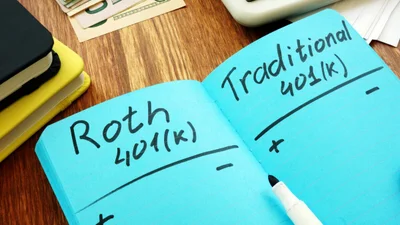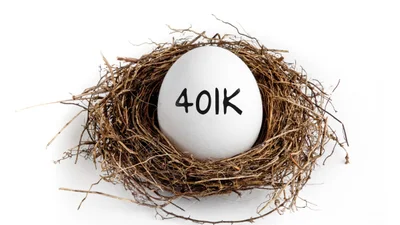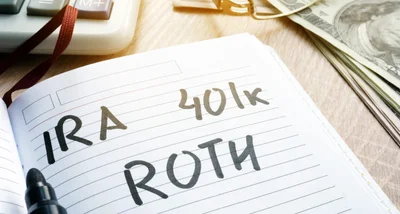401(k) vs. 403(b): Which is best for your retirement?
Published 11:28 a.m. UTC Nov. 28, 2023
Editorial Note: Blueprint may earn a commission from affiliate partner links featured here on our site. This commission does not influence our editors' opinions or evaluations. Please view our full advertiser disclosure policy.

Getty Images
Key points
- 401(k)s are generally offered by private sector companies.
- 403(b)s are found in public schools and certain tax-exempt organizations.
- Both allow you to save for retirement, may offer an employer match and can reduce your taxable income.
Saving for retirement raises important questions. How much do I need to retire? When should I retire? Will my employer help me get there? What kind of retirement savings account should I get?
Two popular options are 403(b) and 401(k) plans. While they share some similarities, they also have unique features and benefits. Let’s compare and contrast 403(b) and 401(k) plans so you can make an informed decision about which one is right for you.
What’s a 401(k)?
A 401(k) is an employer-sponsored retirement plan. Typically, you contribute a portion of each paycheck to your 401(k). Many companies also match your contributions, often up to a certain percentage of your salary. For example, your employer might offer a 100% match on up to 5% of your salary. That’s basically free money for retirement.
Contributions to a traditional 401(k) are deductible from your taxable income, but you have to pay taxes on that money when you withdraw it during retirement.
Roth contributions, on the other hand, are made with after-tax dollars. They aren’t tax deductible. But you don’t pay income taxes on your withdrawals in retirement.
Funds you withdraw from your 401(k) before age 59½ will be subject to an additional 10% tax. There are some exceptions, including distributions made in the following circumstances:
- To someone else under a qualified domestic relations order.
- For medical care, although the amount is limited.
- Because of a qualifying disability.
- On account of certain disasters for which the IRS has granted relief.
- To a beneficiary or an estate after death.
What’s a 403(b)?
A 403(b), also known as a tax-sheltered annuity, is a plan offered by public schools and some tax-exempt organizations that allows employees to save a percentage of their income for retirement.
“It is a retirement account that allows you to put money away, either pretax (traditional) or post-tax (Roth),” said Jay Zigmont, a certified financial planner and founder of Childfree Wealth in Water Valley, Mississippi. “Your employer may make a match contribution to your 403(b) just like a 401(k), or not.”
Like 401(k) withdrawals, 403(b) withdrawals prior to age 59½ will be subject to a 10% penalty unless an exception applies.
What’s the difference?
“A 403(b) is like a 401(k), but it is only for nonprofits and governmental employees. As an employee, a 403(b) works much the same as a 401(k),” Zigmont said.
But the two accounts aren’t necessarily equal when it comes to flexibility. 401(k)s typically offer a bit more in terms of investment options, such as stocks, mutual funds, bonds and other securities, while 403(b)s may be limited to mutual funds and annuities.
403(b)s also may have higher fees, said Eric Phillips, a chartered financial analyst at Human Interest, a retirement savings provider.
“This, in combination with the fact that many organizations don’t have a lot of options when it comes to 403(b) providers, means that many of the current 403(b) plans currently in existence offer employees a confusing set of high-fee funds,” Phillips said.
Then there is the issue of how much you can contribute.
Contributions
Two annual limits apply to contributions to 401(k) and 403(b) plans. Note that these limits apply to the investor, not the plan.
1. Employee contributions
The limit on employee elective deferrals to a 401(k) or 403(b) plan is $23,000 in 2024.
Both plans also offer catch-up contributions of $7,500 per year for those age 50 and older.
But 403(b) plans may offer an additional catch-up contribution for employees with at least 15 years of service with the same eligible employer. The 15-year catch-up is the lesser of the following:
- $3,000.
- $15,000 reduced by the amount of additional elective deferrals made in prior years because of this rule.
- $5,000 multiplied by the number of the employee’s years of service for the organization, minus the total elective deferrals made for earlier years.
You do not have to be 50 or older to be eligible for this catch-up contribution. But if you are 50 or older, you can make the regular contribution and both types of catch-up contributions to your 403(b) plan in the same year.
Example: Let’s say you’re a 55-year-old state social worker and you’ve been in your job for 15 years. You can contribute $23,000 to your 403(b) plus $7,500 because you’re over 50 and $3,000 as an employee with 15 years of service to your current employer. That is a total possible contribution of $33,500.
2. Combined contributions
The combined limit for employee elective deferrals and employer contributions to a 401(k) or 403(b) plan in 2024 is $69,000 or 100% of your salary, whichever is lower. That number does not include catch-up contributions.
Which is better for you?
Although 401(k)s and 403(b)s are both retirement accounts, they aren’t typically offered by the same employers. 401(k)s are generally offered by private sector companies, while 403(b)s are found in public schools and some tax-exempt organizations. And you can’t open a 401(k) or 403(b) on your own the way you can open an individual retirement account (IRA). It has to come via your employer.
So, ultimately, it isn’t really a question of which is better, as you probably won’t be in a situation where you have to choose between a 401(k) and 403(b). Instead, it’s about making sure you put enough money toward your retirement.
If you’re looking to maximize your retirement savings, consider opening an IRA to stash extra cash — even if you have a 401(k) or 403(b). IRA contributions are limited to $7,000 per year (or $8,000 if you’re 50 or older).
For 2024, the contribution limit is $23,000 for employee elective deferrals to a 403(b) or 401(k).
Individuals who are 50 or older can also make catch-up contributions of up to $7,500. And 403(b)s offer an additional catch-up contribution for employees with at least 15 years of service.
The combined limit for employee elective deferrals and employer contributions is the lesser of $69,000, not including catch-up contributions, or 100% of your salary.
403(b) and 401(k) plans are very similar, and one is not necessarily better than the other. Although the plans’ investment offerings and fees may differ, the biggest difference lies in the types of employer that offer them. Private sector companies offer 401(k)s, while 403(b)s are available to employees in public schools and certain tax-exempt organizations. The important thing is that both plans help you save for retirement in a tax-advantaged way.
Blueprint is an independent publisher and comparison service, not an investment advisor. The information provided is for educational purposes only and we encourage you to seek personalized advice from qualified professionals regarding specific financial decisions. Past performance is not indicative of future results.
Blueprint has an advertiser disclosure policy. The opinions, analyses, reviews or recommendations expressed in this article are those of the Blueprint editorial staff alone. Blueprint adheres to strict editorial integrity standards. The information is accurate as of the publish date, but always check the provider’s website for the most current information.
















